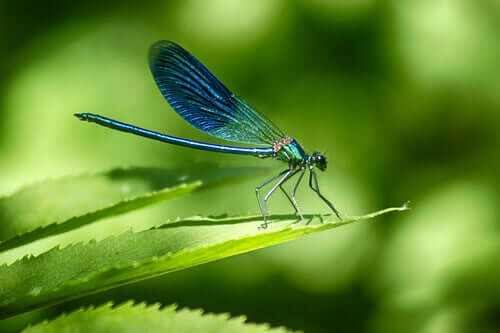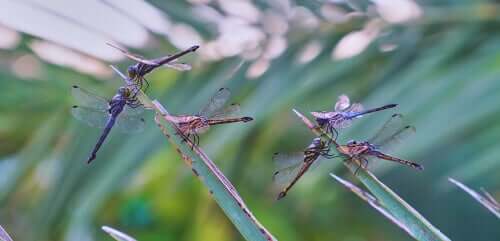Learn About the Metamorphosis of the Dragonfly


Written and verified by the biologist Paloma de los Milagros
Whether its life-cycle lasts less than six months or more than five years, the metamorphosis of the dragonfly is morphologically and physiologically complex.
Anisoptera belong to one of the two sub-orders which make up the order Odonata which includes more than 5,000 species of insects. They’re commonly known as dragonflies or damselflies, although this term is not very specific as it’s often used for all odonates.
The three stages of the metamorphosis of the dragonfly
Just like with any other species, reproduction begins with intercourse. However, dragonflies have the particular ability to be able to mate in full flight. Once they finish, the female usually lays her eggs in vegetation, in areas close to some calm water. In some cases, they can lay up to 500 eggs.
After they hatch, the nymph phase begins. This is the longest stage in the metamorphosis and can even last for longer than four years. During this stage, the nymphs grow and develop in their aquatic surroundings, capturing small invertebrates using their powerful jaws.

Depending on the species, they can molt numerous times, gradually developing their wings, and their initial “hunchback” appearance progressively disappears. They also stop using their gills so that they are able to breathe when first exposed to the air.
Once spring arrives and they’ve acquired their elongated abdomen, folded wings, and prominent eyes, the dragonfly begins the adult phase out of the water. To do this, it crawls out of its larval skin, known as the exuvia.
During the first days of this new stage, the dragonfly gets used to its surroundings, strengthening its legs and wings. It has to avoid attacks from predators that it barely encountered as a nymph.
It’s also worth pointing out the significant change in its way of moving during the transition from nymph to dragonfly. As a nymph, they move quickly through the water by expelling water through the anus. Now, as dragonflies, they are able to accurately propel themselves in the air in six different directions.

Although there are exceptional cases, for most species the adult stage lasts just a few months. This means that as soon as they’re out of the water, their main objective is to find a partner to mate with in order to begin the whole life cycle again.
Global distribution of dragonflies
Currently, some 5,700 species of dragonflies have been discovered around the world. And, although they’re more commonly found in the tropics, such as in Mexico where there are around 360 species, there are around 450 species across the USA and Canada.
Although most dragonflies spend most of their lives around aquatic environments with dense vegetation, others can migrate long distances, such as the genus Libellula, Sympetrum or Pantala.
All cited sources were thoroughly reviewed by our team to ensure their quality, reliability, currency, and validity. The bibliography of this article was considered reliable and of academic or scientific accuracy.
- Pérez de Albéniz, J. El Mundo. Cinco años para convertirse en libélula. (s.f). Recuperado de https://www.elmundo.es/larevista/num158/textos/libe.html
- Okdiario. (2018). Descubre el ciclo de vida de la libélula. Recuperado de https://okdiario.com/curiosidades/ciclo-vida-libelula-3138323
This text is provided for informational purposes only and does not replace consultation with a professional. If in doubt, consult your specialist.